Management 4: Humanitarian Logistics and Supply Chain Report
VerifiedAdded on 2022/10/19
|17
|3449
|250
Report
AI Summary
This report provides a comprehensive analysis of humanitarian logistics and supply chain management, focusing on resilience, agility, and decision-making processes. It explores the vulnerabilities within supply chains, both internal and external, and discusses strategies to mitigate risks and enhance adaptability. The report examines the differences between agile and resilient supply chains, highlighting their respective strengths and applications in responding to disruptions. It also delves into collective and analytical decision-making processes within humanitarian contexts, including the steps involved in humanitarian logistics and the role of NGOs. The study references a case study of the 2004 tsunami to highlight the importance of building resilient supply chains and explores strategies for enhancing NGO agility and creating overall organizational resilience. The report concludes with recommendations for boosting supply chain agility and resilience, emphasizing the importance of foresight, innovation, and collaborative efforts.
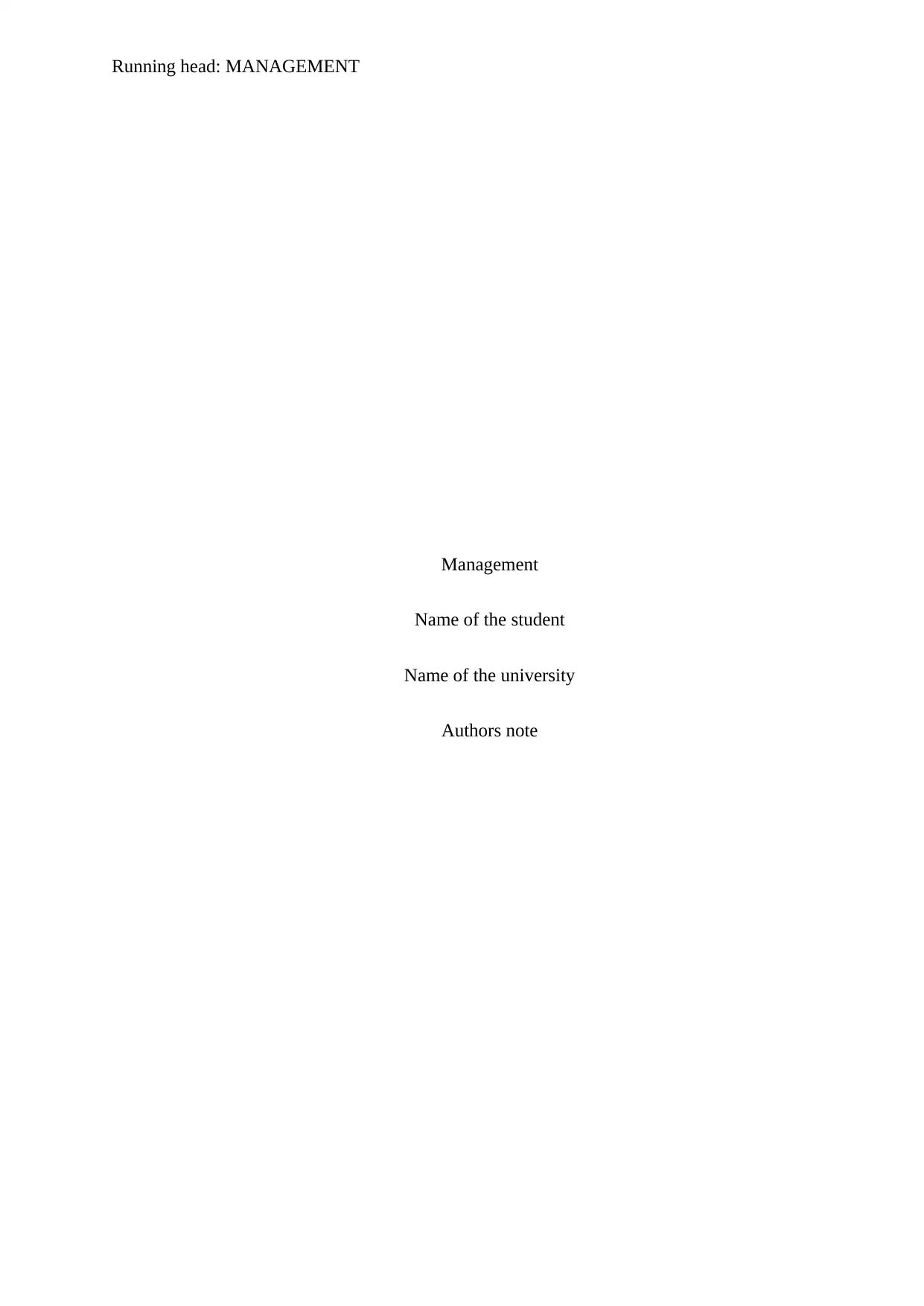
Running head: MANAGEMENT
Management
Name of the student
Name of the university
Authors note
Management
Name of the student
Name of the university
Authors note
Paraphrase This Document
Need a fresh take? Get an instant paraphrase of this document with our AI Paraphraser
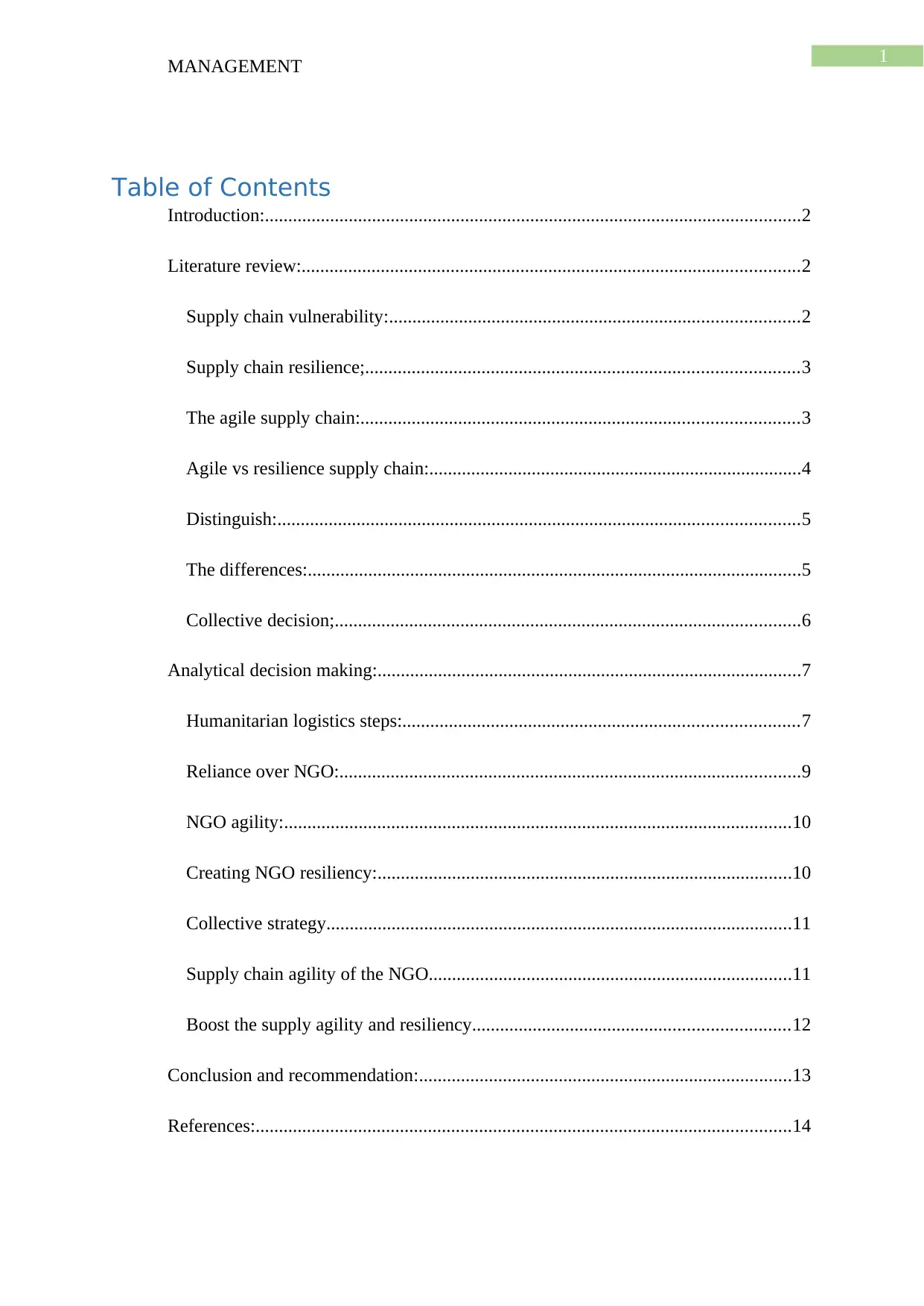
1
MANAGEMENT
Table of Contents
Introduction:...................................................................................................................2
Literature review:...........................................................................................................2
Supply chain vulnerability:........................................................................................2
Supply chain resilience;.............................................................................................3
The agile supply chain:..............................................................................................3
Agile vs resilience supply chain:................................................................................4
Distinguish:................................................................................................................5
The differences:..........................................................................................................5
Collective decision;....................................................................................................6
Analytical decision making:...........................................................................................7
Humanitarian logistics steps:.....................................................................................7
Reliance over NGO:...................................................................................................9
NGO agility:.............................................................................................................10
Creating NGO resiliency:.........................................................................................10
Collective strategy....................................................................................................11
Supply chain agility of the NGO..............................................................................11
Boost the supply agility and resiliency....................................................................12
Conclusion and recommendation:................................................................................13
References:...................................................................................................................14
MANAGEMENT
Table of Contents
Introduction:...................................................................................................................2
Literature review:...........................................................................................................2
Supply chain vulnerability:........................................................................................2
Supply chain resilience;.............................................................................................3
The agile supply chain:..............................................................................................3
Agile vs resilience supply chain:................................................................................4
Distinguish:................................................................................................................5
The differences:..........................................................................................................5
Collective decision;....................................................................................................6
Analytical decision making:...........................................................................................7
Humanitarian logistics steps:.....................................................................................7
Reliance over NGO:...................................................................................................9
NGO agility:.............................................................................................................10
Creating NGO resiliency:.........................................................................................10
Collective strategy....................................................................................................11
Supply chain agility of the NGO..............................................................................11
Boost the supply agility and resiliency....................................................................12
Conclusion and recommendation:................................................................................13
References:...................................................................................................................14
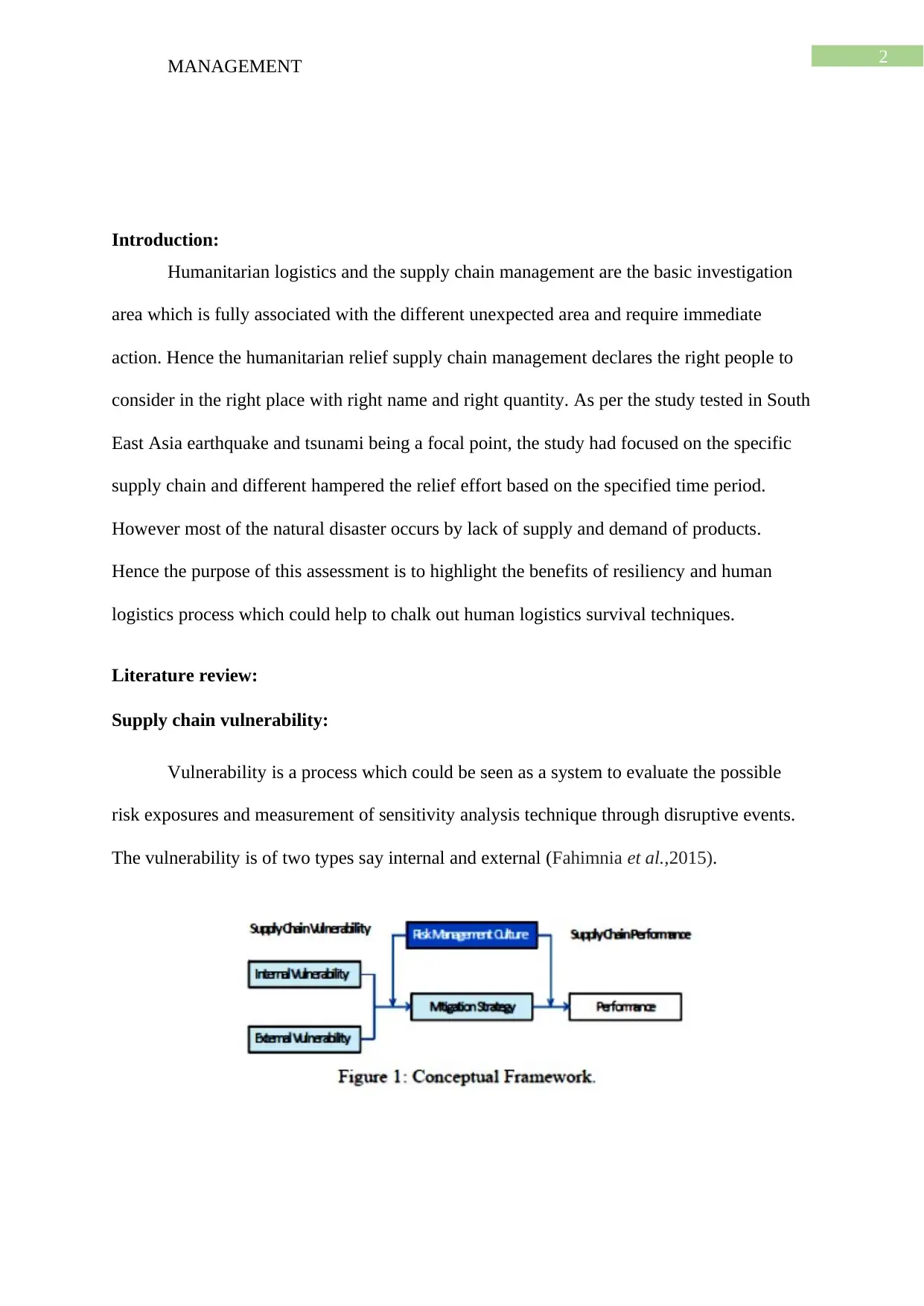
2
MANAGEMENT
Introduction:
Humanitarian logistics and the supply chain management are the basic investigation
area which is fully associated with the different unexpected area and require immediate
action. Hence the humanitarian relief supply chain management declares the right people to
consider in the right place with right name and right quantity. As per the study tested in South
East Asia earthquake and tsunami being a focal point, the study had focused on the specific
supply chain and different hampered the relief effort based on the specified time period.
However most of the natural disaster occurs by lack of supply and demand of products.
Hence the purpose of this assessment is to highlight the benefits of resiliency and human
logistics process which could help to chalk out human logistics survival techniques.
Literature review:
Supply chain vulnerability:
Vulnerability is a process which could be seen as a system to evaluate the possible
risk exposures and measurement of sensitivity analysis technique through disruptive events.
The vulnerability is of two types say internal and external (Fahimnia et al.,2015).
MANAGEMENT
Introduction:
Humanitarian logistics and the supply chain management are the basic investigation
area which is fully associated with the different unexpected area and require immediate
action. Hence the humanitarian relief supply chain management declares the right people to
consider in the right place with right name and right quantity. As per the study tested in South
East Asia earthquake and tsunami being a focal point, the study had focused on the specific
supply chain and different hampered the relief effort based on the specified time period.
However most of the natural disaster occurs by lack of supply and demand of products.
Hence the purpose of this assessment is to highlight the benefits of resiliency and human
logistics process which could help to chalk out human logistics survival techniques.
Literature review:
Supply chain vulnerability:
Vulnerability is a process which could be seen as a system to evaluate the possible
risk exposures and measurement of sensitivity analysis technique through disruptive events.
The vulnerability is of two types say internal and external (Fahimnia et al.,2015).
⊘ This is a preview!⊘
Do you want full access?
Subscribe today to unlock all pages.

Trusted by 1+ million students worldwide
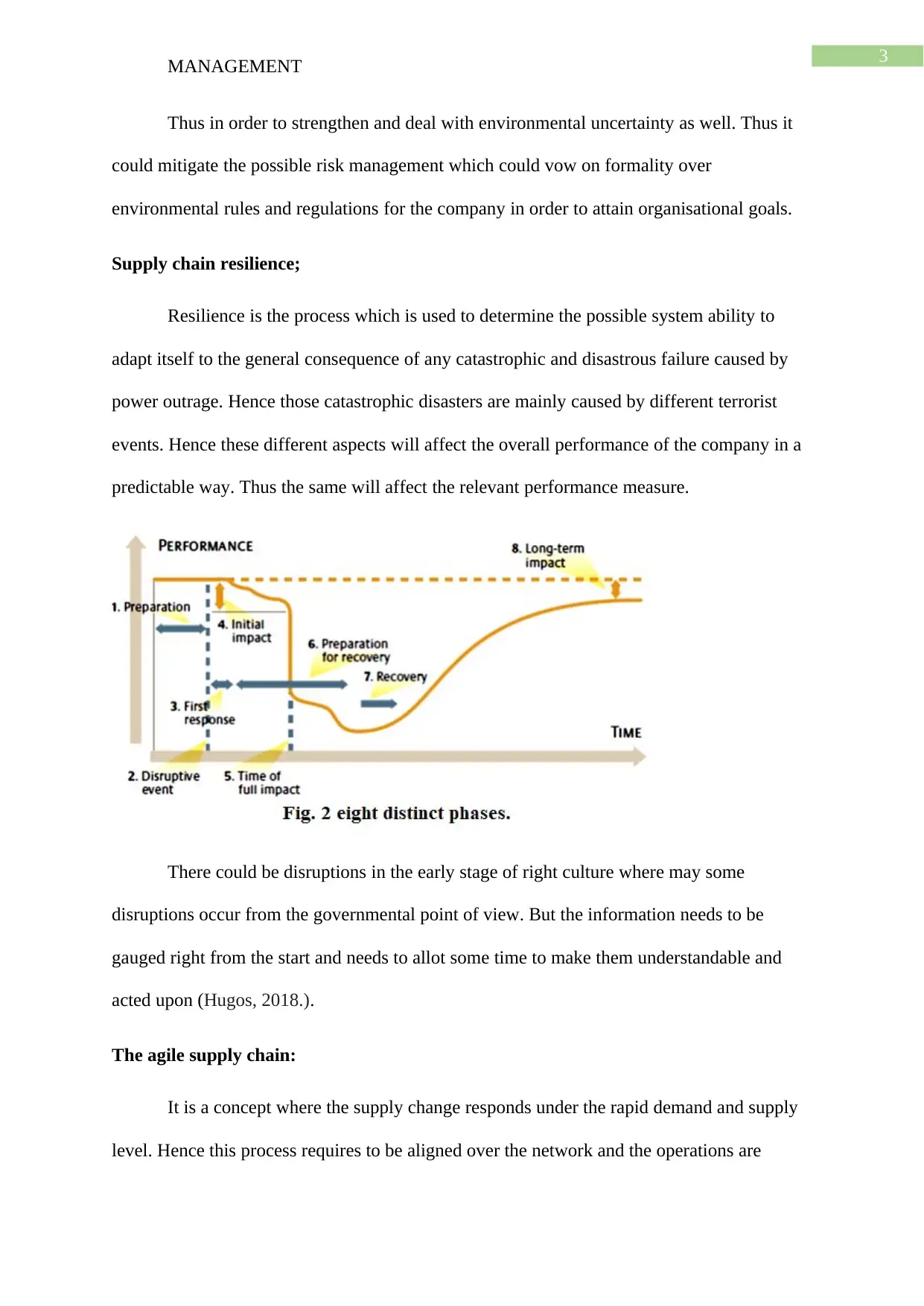
3
MANAGEMENT
Thus in order to strengthen and deal with environmental uncertainty as well. Thus it
could mitigate the possible risk management which could vow on formality over
environmental rules and regulations for the company in order to attain organisational goals.
Supply chain resilience;
Resilience is the process which is used to determine the possible system ability to
adapt itself to the general consequence of any catastrophic and disastrous failure caused by
power outrage. Hence those catastrophic disasters are mainly caused by different terrorist
events. Hence these different aspects will affect the overall performance of the company in a
predictable way. Thus the same will affect the relevant performance measure.
There could be disruptions in the early stage of right culture where may some
disruptions occur from the governmental point of view. But the information needs to be
gauged right from the start and needs to allot some time to make them understandable and
acted upon (Hugos, 2018.).
The agile supply chain:
It is a concept where the supply change responds under the rapid demand and supply
level. Hence this process requires to be aligned over the network and the operations are
MANAGEMENT
Thus in order to strengthen and deal with environmental uncertainty as well. Thus it
could mitigate the possible risk management which could vow on formality over
environmental rules and regulations for the company in order to attain organisational goals.
Supply chain resilience;
Resilience is the process which is used to determine the possible system ability to
adapt itself to the general consequence of any catastrophic and disastrous failure caused by
power outrage. Hence those catastrophic disasters are mainly caused by different terrorist
events. Hence these different aspects will affect the overall performance of the company in a
predictable way. Thus the same will affect the relevant performance measure.
There could be disruptions in the early stage of right culture where may some
disruptions occur from the governmental point of view. But the information needs to be
gauged right from the start and needs to allot some time to make them understandable and
acted upon (Hugos, 2018.).
The agile supply chain:
It is a concept where the supply change responds under the rapid demand and supply
level. Hence this process requires to be aligned over the network and the operations are
Paraphrase This Document
Need a fresh take? Get an instant paraphrase of this document with our AI Paraphraser
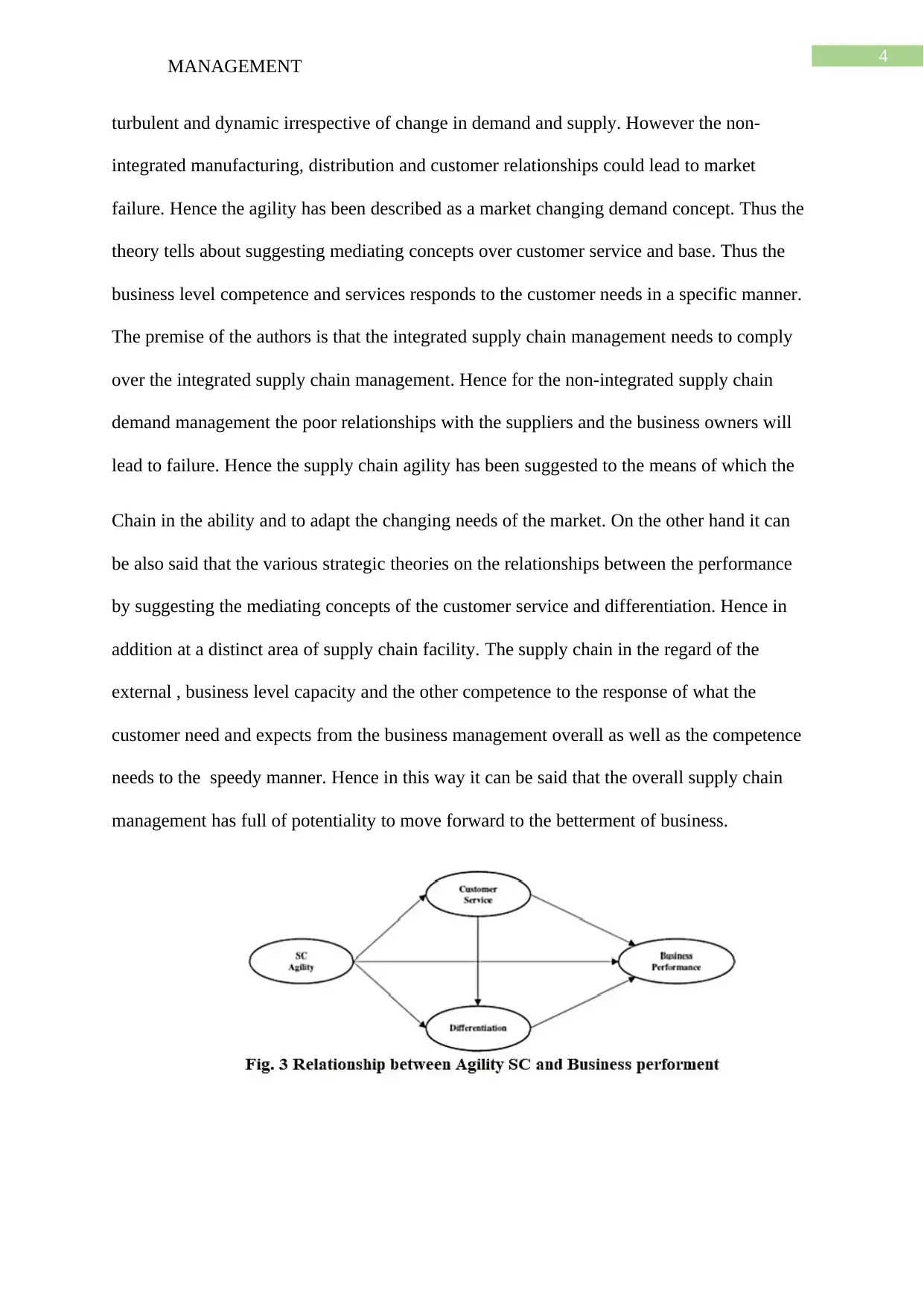
4
MANAGEMENT
turbulent and dynamic irrespective of change in demand and supply. However the non-
integrated manufacturing, distribution and customer relationships could lead to market
failure. Hence the agility has been described as a market changing demand concept. Thus the
theory tells about suggesting mediating concepts over customer service and base. Thus the
business level competence and services responds to the customer needs in a specific manner.
The premise of the authors is that the integrated supply chain management needs to comply
over the integrated supply chain management. Hence for the non-integrated supply chain
demand management the poor relationships with the suppliers and the business owners will
lead to failure. Hence the supply chain agility has been suggested to the means of which the
Chain in the ability and to adapt the changing needs of the market. On the other hand it can
be also said that the various strategic theories on the relationships between the performance
by suggesting the mediating concepts of the customer service and differentiation. Hence in
addition at a distinct area of supply chain facility. The supply chain in the regard of the
external , business level capacity and the other competence to the response of what the
customer need and expects from the business management overall as well as the competence
needs to the speedy manner. Hence in this way it can be said that the overall supply chain
management has full of potentiality to move forward to the betterment of business.
MANAGEMENT
turbulent and dynamic irrespective of change in demand and supply. However the non-
integrated manufacturing, distribution and customer relationships could lead to market
failure. Hence the agility has been described as a market changing demand concept. Thus the
theory tells about suggesting mediating concepts over customer service and base. Thus the
business level competence and services responds to the customer needs in a specific manner.
The premise of the authors is that the integrated supply chain management needs to comply
over the integrated supply chain management. Hence for the non-integrated supply chain
demand management the poor relationships with the suppliers and the business owners will
lead to failure. Hence the supply chain agility has been suggested to the means of which the
Chain in the ability and to adapt the changing needs of the market. On the other hand it can
be also said that the various strategic theories on the relationships between the performance
by suggesting the mediating concepts of the customer service and differentiation. Hence in
addition at a distinct area of supply chain facility. The supply chain in the regard of the
external , business level capacity and the other competence to the response of what the
customer need and expects from the business management overall as well as the competence
needs to the speedy manner. Hence in this way it can be said that the overall supply chain
management has full of potentiality to move forward to the betterment of business.
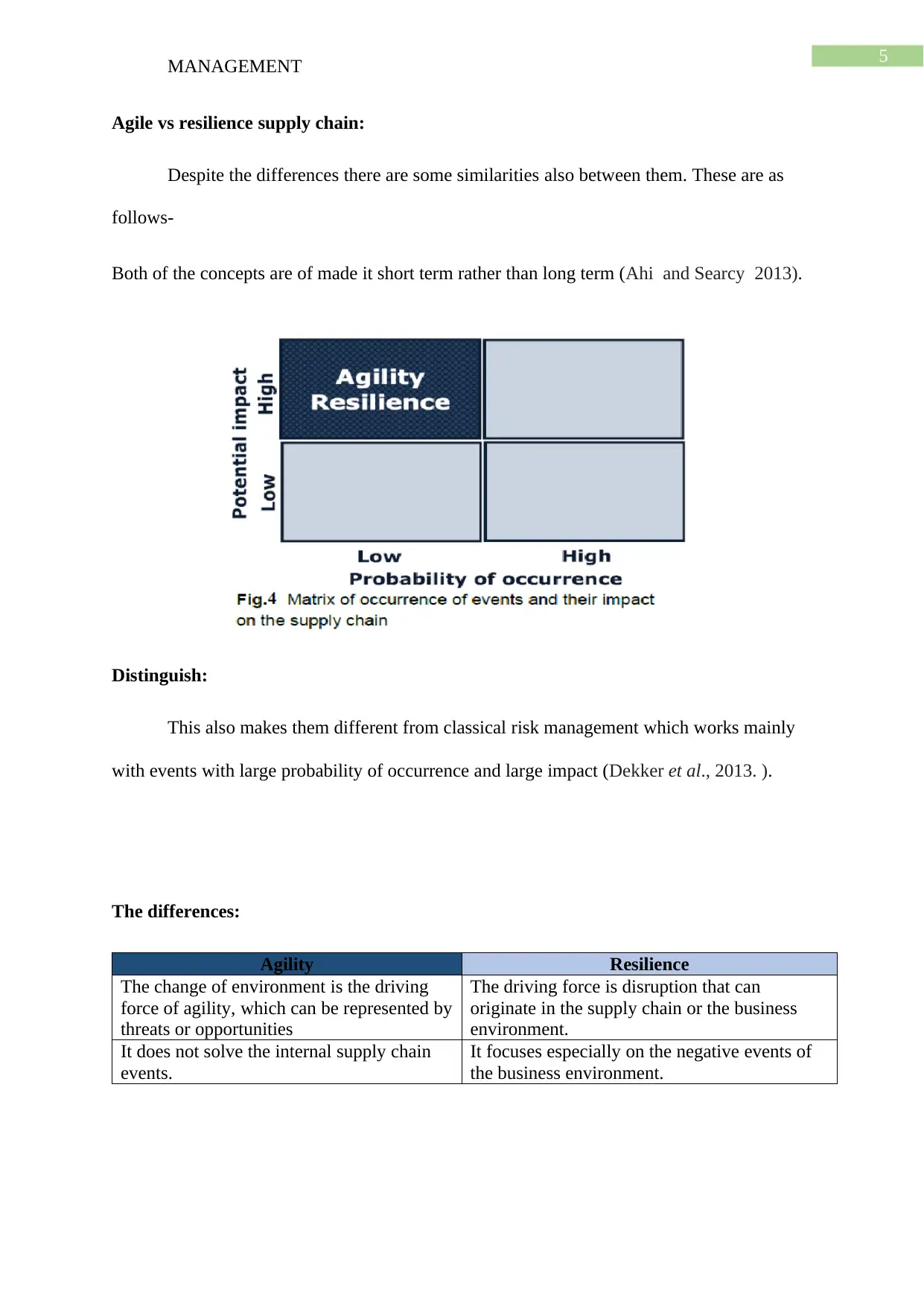
5
MANAGEMENT
Agile vs resilience supply chain:
Despite the differences there are some similarities also between them. These are as
follows-
Both of the concepts are of made it short term rather than long term (Ahi and Searcy 2013).
Distinguish:
This also makes them different from classical risk management which works mainly
with events with large probability of occurrence and large impact (Dekker et al., 2013. ).
The differences:
Agility Resilience
The change of environment is the driving
force of agility, which can be represented by
threats or opportunities
The driving force is disruption that can
originate in the supply chain or the business
environment.
It does not solve the internal supply chain
events.
It focuses especially on the negative events of
the business environment.
MANAGEMENT
Agile vs resilience supply chain:
Despite the differences there are some similarities also between them. These are as
follows-
Both of the concepts are of made it short term rather than long term (Ahi and Searcy 2013).
Distinguish:
This also makes them different from classical risk management which works mainly
with events with large probability of occurrence and large impact (Dekker et al., 2013. ).
The differences:
Agility Resilience
The change of environment is the driving
force of agility, which can be represented by
threats or opportunities
The driving force is disruption that can
originate in the supply chain or the business
environment.
It does not solve the internal supply chain
events.
It focuses especially on the negative events of
the business environment.
⊘ This is a preview!⊘
Do you want full access?
Subscribe today to unlock all pages.

Trusted by 1+ million students worldwide
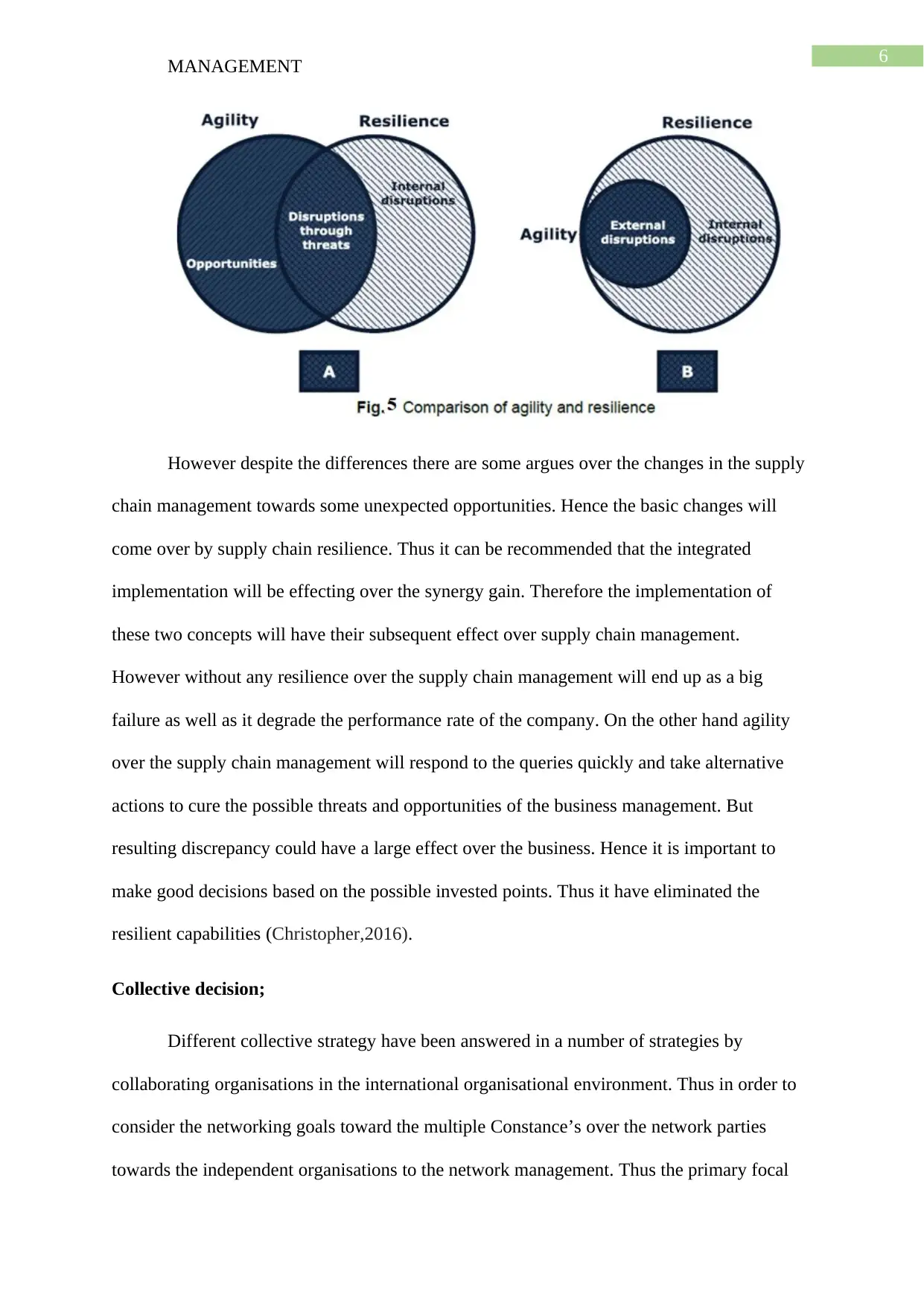
6
MANAGEMENT
However despite the differences there are some argues over the changes in the supply
chain management towards some unexpected opportunities. Hence the basic changes will
come over by supply chain resilience. Thus it can be recommended that the integrated
implementation will be effecting over the synergy gain. Therefore the implementation of
these two concepts will have their subsequent effect over supply chain management.
However without any resilience over the supply chain management will end up as a big
failure as well as it degrade the performance rate of the company. On the other hand agility
over the supply chain management will respond to the queries quickly and take alternative
actions to cure the possible threats and opportunities of the business management. But
resulting discrepancy could have a large effect over the business. Hence it is important to
make good decisions based on the possible invested points. Thus it have eliminated the
resilient capabilities (Christopher,2016).
Collective decision;
Different collective strategy have been answered in a number of strategies by
collaborating organisations in the international organisational environment. Thus in order to
consider the networking goals toward the multiple Constance’s over the network parties
towards the independent organisations to the network management. Thus the primary focal
MANAGEMENT
However despite the differences there are some argues over the changes in the supply
chain management towards some unexpected opportunities. Hence the basic changes will
come over by supply chain resilience. Thus it can be recommended that the integrated
implementation will be effecting over the synergy gain. Therefore the implementation of
these two concepts will have their subsequent effect over supply chain management.
However without any resilience over the supply chain management will end up as a big
failure as well as it degrade the performance rate of the company. On the other hand agility
over the supply chain management will respond to the queries quickly and take alternative
actions to cure the possible threats and opportunities of the business management. But
resulting discrepancy could have a large effect over the business. Hence it is important to
make good decisions based on the possible invested points. Thus it have eliminated the
resilient capabilities (Christopher,2016).
Collective decision;
Different collective strategy have been answered in a number of strategies by
collaborating organisations in the international organisational environment. Thus in order to
consider the networking goals toward the multiple Constance’s over the network parties
towards the independent organisations to the network management. Thus the primary focal
Paraphrase This Document
Need a fresh take? Get an instant paraphrase of this document with our AI Paraphraser
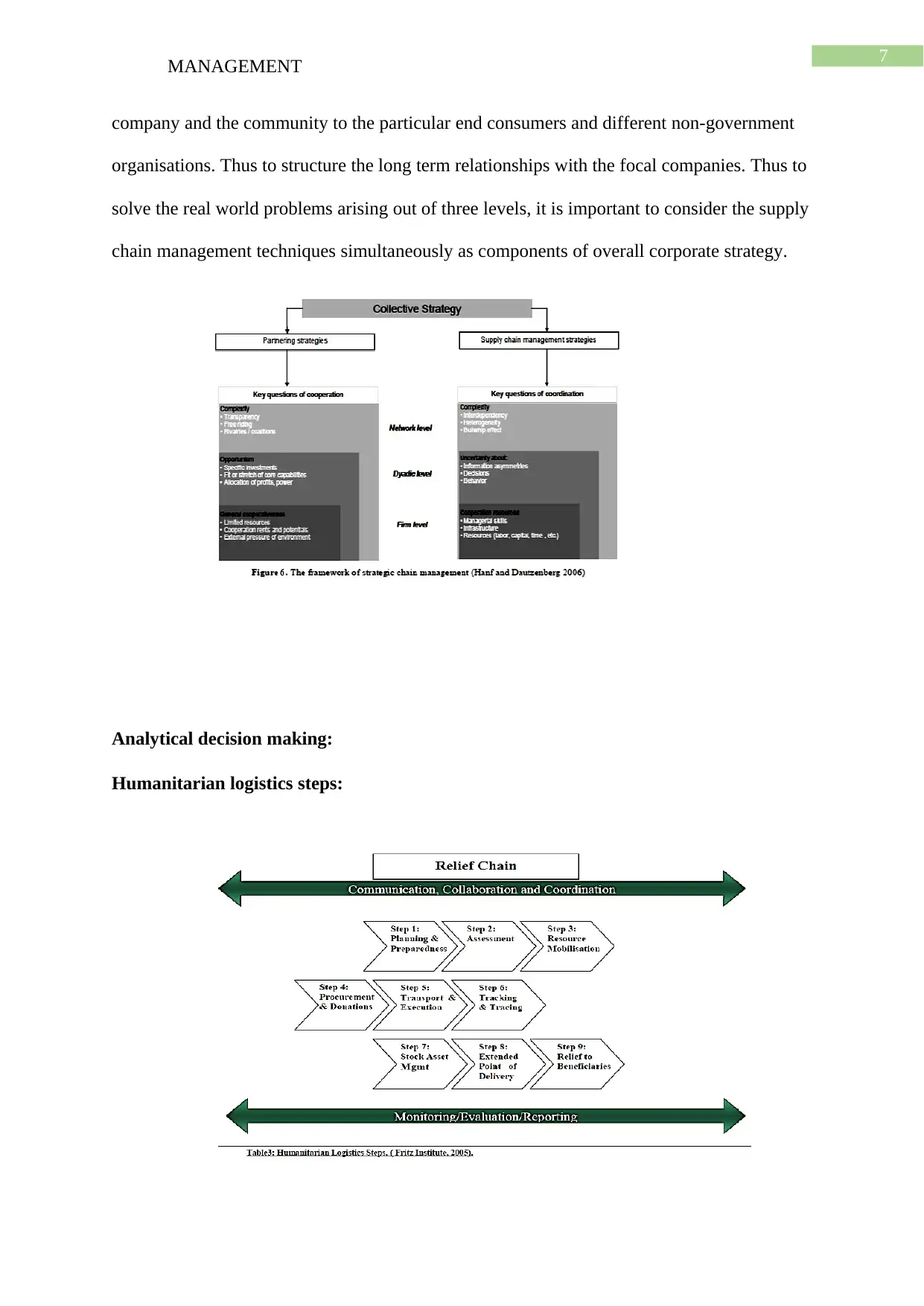
7
MANAGEMENT
company and the community to the particular end consumers and different non-government
organisations. Thus to structure the long term relationships with the focal companies. Thus to
solve the real world problems arising out of three levels, it is important to consider the supply
chain management techniques simultaneously as components of overall corporate strategy.
Analytical decision making:
Humanitarian logistics steps:
MANAGEMENT
company and the community to the particular end consumers and different non-government
organisations. Thus to structure the long term relationships with the focal companies. Thus to
solve the real world problems arising out of three levels, it is important to consider the supply
chain management techniques simultaneously as components of overall corporate strategy.
Analytical decision making:
Humanitarian logistics steps:
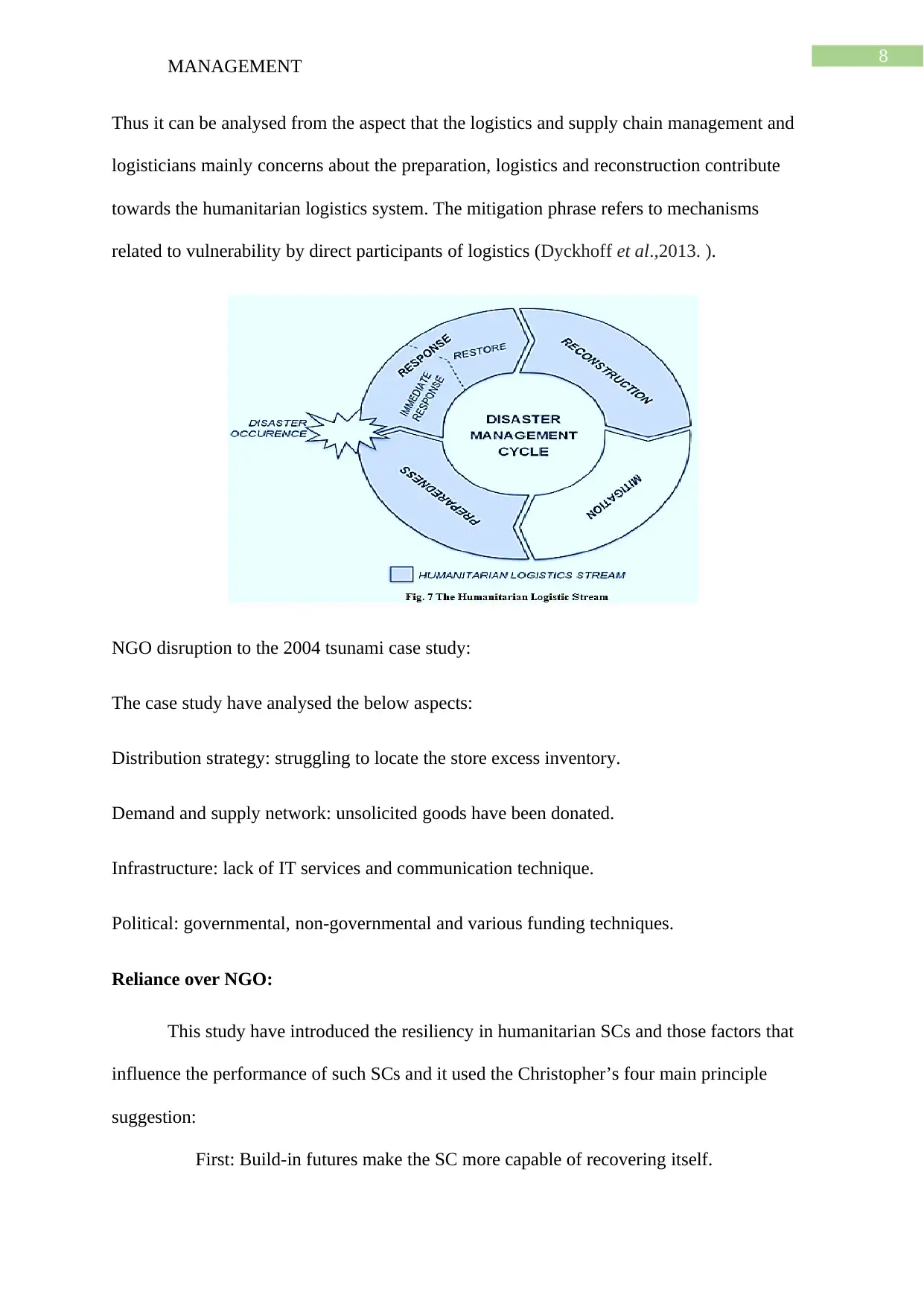
8
MANAGEMENT
Thus it can be analysed from the aspect that the logistics and supply chain management and
logisticians mainly concerns about the preparation, logistics and reconstruction contribute
towards the humanitarian logistics system. The mitigation phrase refers to mechanisms
related to vulnerability by direct participants of logistics (Dyckhoff et al.,2013. ).
NGO disruption to the 2004 tsunami case study:
The case study have analysed the below aspects:
Distribution strategy: struggling to locate the store excess inventory.
Demand and supply network: unsolicited goods have been donated.
Infrastructure: lack of IT services and communication technique.
Political: governmental, non-governmental and various funding techniques.
Reliance over NGO:
This study have introduced the resiliency in humanitarian SCs and those factors that
influence the performance of such SCs and it used the Christopher’s four main principle
suggestion:
First: Build-in futures make the SC more capable of recovering itself.
MANAGEMENT
Thus it can be analysed from the aspect that the logistics and supply chain management and
logisticians mainly concerns about the preparation, logistics and reconstruction contribute
towards the humanitarian logistics system. The mitigation phrase refers to mechanisms
related to vulnerability by direct participants of logistics (Dyckhoff et al.,2013. ).
NGO disruption to the 2004 tsunami case study:
The case study have analysed the below aspects:
Distribution strategy: struggling to locate the store excess inventory.
Demand and supply network: unsolicited goods have been donated.
Infrastructure: lack of IT services and communication technique.
Political: governmental, non-governmental and various funding techniques.
Reliance over NGO:
This study have introduced the resiliency in humanitarian SCs and those factors that
influence the performance of such SCs and it used the Christopher’s four main principle
suggestion:
First: Build-in futures make the SC more capable of recovering itself.
⊘ This is a preview!⊘
Do you want full access?
Subscribe today to unlock all pages.

Trusted by 1+ million students worldwide
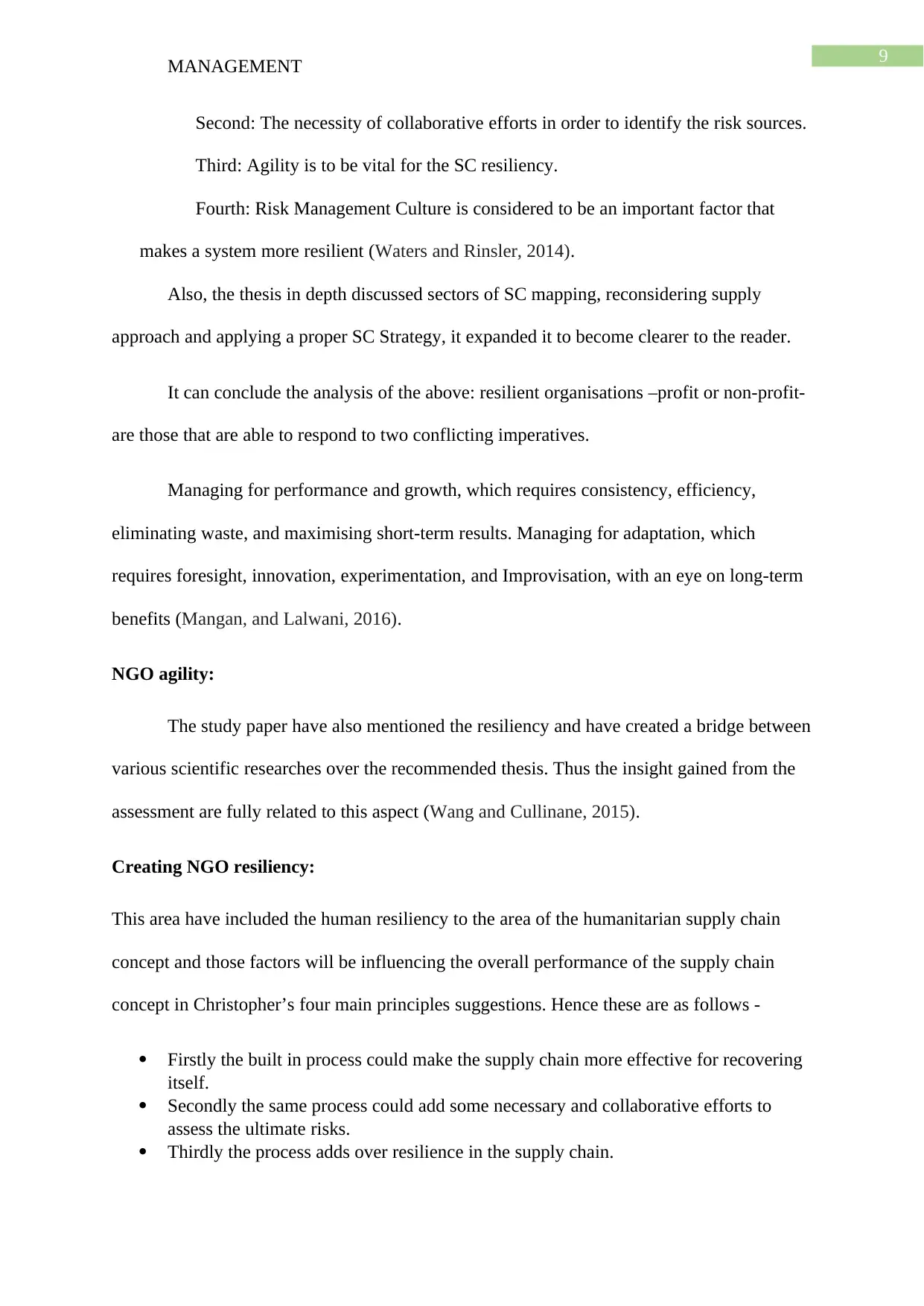
9
MANAGEMENT
Second: The necessity of collaborative efforts in order to identify the risk sources.
Third: Agility is to be vital for the SC resiliency.
Fourth: Risk Management Culture is considered to be an important factor that
makes a system more resilient (Waters and Rinsler, 2014).
Also, the thesis in depth discussed sectors of SC mapping, reconsidering supply
approach and applying a proper SC Strategy, it expanded it to become clearer to the reader.
It can conclude the analysis of the above: resilient organisations –profit or non-profit-
are those that are able to respond to two conflicting imperatives.
Managing for performance and growth, which requires consistency, efficiency,
eliminating waste, and maximising short-term results. Managing for adaptation, which
requires foresight, innovation, experimentation, and Improvisation, with an eye on long-term
benefits (Mangan, and Lalwani, 2016).
NGO agility:
The study paper have also mentioned the resiliency and have created a bridge between
various scientific researches over the recommended thesis. Thus the insight gained from the
assessment are fully related to this aspect (Wang and Cullinane, 2015).
Creating NGO resiliency:
This area have included the human resiliency to the area of the humanitarian supply chain
concept and those factors will be influencing the overall performance of the supply chain
concept in Christopher’s four main principles suggestions. Hence these are as follows -
Firstly the built in process could make the supply chain more effective for recovering
itself.
Secondly the same process could add some necessary and collaborative efforts to
assess the ultimate risks.
Thirdly the process adds over resilience in the supply chain.
MANAGEMENT
Second: The necessity of collaborative efforts in order to identify the risk sources.
Third: Agility is to be vital for the SC resiliency.
Fourth: Risk Management Culture is considered to be an important factor that
makes a system more resilient (Waters and Rinsler, 2014).
Also, the thesis in depth discussed sectors of SC mapping, reconsidering supply
approach and applying a proper SC Strategy, it expanded it to become clearer to the reader.
It can conclude the analysis of the above: resilient organisations –profit or non-profit-
are those that are able to respond to two conflicting imperatives.
Managing for performance and growth, which requires consistency, efficiency,
eliminating waste, and maximising short-term results. Managing for adaptation, which
requires foresight, innovation, experimentation, and Improvisation, with an eye on long-term
benefits (Mangan, and Lalwani, 2016).
NGO agility:
The study paper have also mentioned the resiliency and have created a bridge between
various scientific researches over the recommended thesis. Thus the insight gained from the
assessment are fully related to this aspect (Wang and Cullinane, 2015).
Creating NGO resiliency:
This area have included the human resiliency to the area of the humanitarian supply chain
concept and those factors will be influencing the overall performance of the supply chain
concept in Christopher’s four main principles suggestions. Hence these are as follows -
Firstly the built in process could make the supply chain more effective for recovering
itself.
Secondly the same process could add some necessary and collaborative efforts to
assess the ultimate risks.
Thirdly the process adds over resilience in the supply chain.
Paraphrase This Document
Need a fresh take? Get an instant paraphrase of this document with our AI Paraphraser
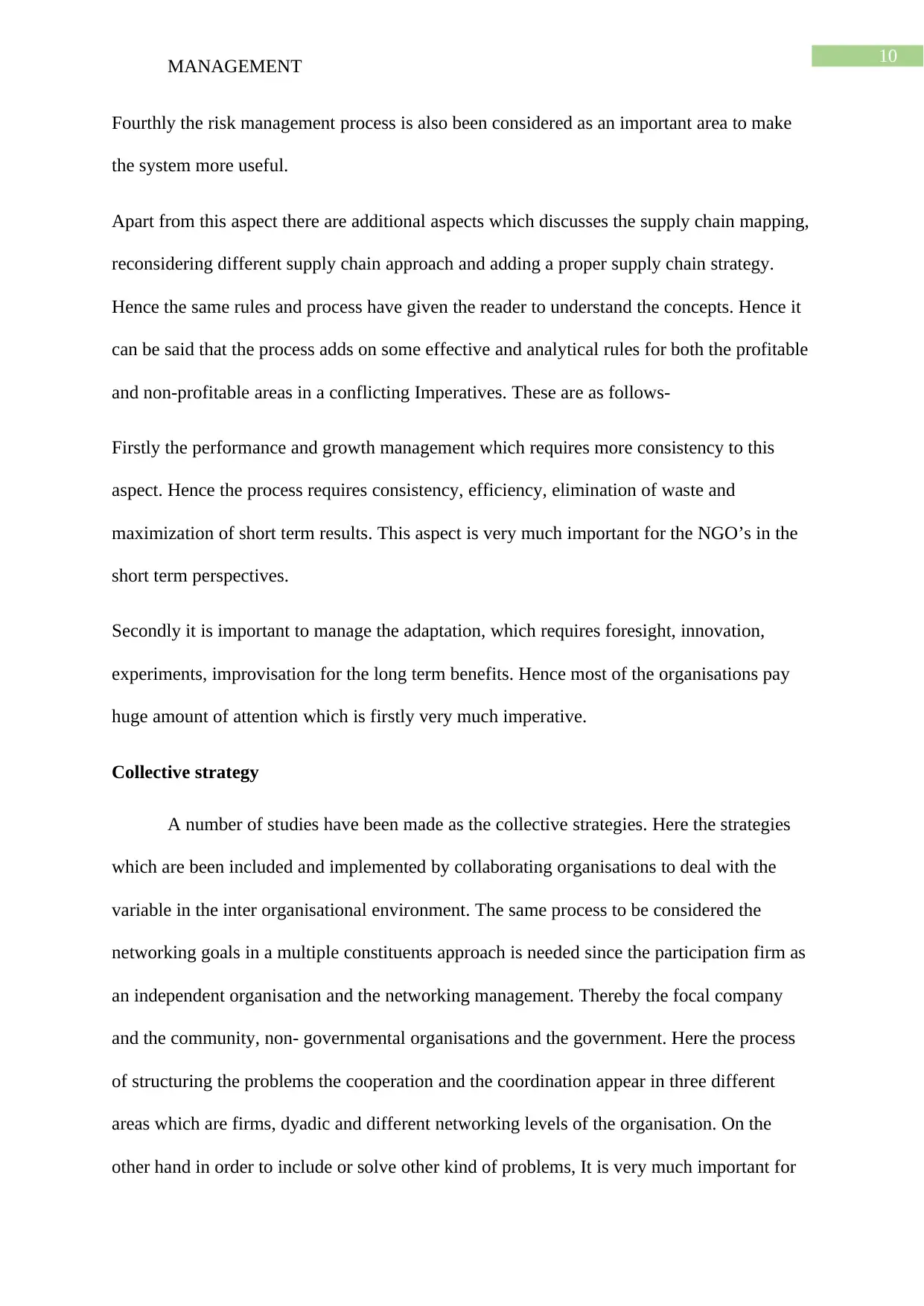
10
MANAGEMENT
Fourthly the risk management process is also been considered as an important area to make
the system more useful.
Apart from this aspect there are additional aspects which discusses the supply chain mapping,
reconsidering different supply chain approach and adding a proper supply chain strategy.
Hence the same rules and process have given the reader to understand the concepts. Hence it
can be said that the process adds on some effective and analytical rules for both the profitable
and non-profitable areas in a conflicting Imperatives. These are as follows-
Firstly the performance and growth management which requires more consistency to this
aspect. Hence the process requires consistency, efficiency, elimination of waste and
maximization of short term results. This aspect is very much important for the NGO’s in the
short term perspectives.
Secondly it is important to manage the adaptation, which requires foresight, innovation,
experiments, improvisation for the long term benefits. Hence most of the organisations pay
huge amount of attention which is firstly very much imperative.
Collective strategy
A number of studies have been made as the collective strategies. Here the strategies
which are been included and implemented by collaborating organisations to deal with the
variable in the inter organisational environment. The same process to be considered the
networking goals in a multiple constituents approach is needed since the participation firm as
an independent organisation and the networking management. Thereby the focal company
and the community, non- governmental organisations and the government. Here the process
of structuring the problems the cooperation and the coordination appear in three different
areas which are firms, dyadic and different networking levels of the organisation. On the
other hand in order to include or solve other kind of problems, It is very much important for
MANAGEMENT
Fourthly the risk management process is also been considered as an important area to make
the system more useful.
Apart from this aspect there are additional aspects which discusses the supply chain mapping,
reconsidering different supply chain approach and adding a proper supply chain strategy.
Hence the same rules and process have given the reader to understand the concepts. Hence it
can be said that the process adds on some effective and analytical rules for both the profitable
and non-profitable areas in a conflicting Imperatives. These are as follows-
Firstly the performance and growth management which requires more consistency to this
aspect. Hence the process requires consistency, efficiency, elimination of waste and
maximization of short term results. This aspect is very much important for the NGO’s in the
short term perspectives.
Secondly it is important to manage the adaptation, which requires foresight, innovation,
experiments, improvisation for the long term benefits. Hence most of the organisations pay
huge amount of attention which is firstly very much imperative.
Collective strategy
A number of studies have been made as the collective strategies. Here the strategies
which are been included and implemented by collaborating organisations to deal with the
variable in the inter organisational environment. The same process to be considered the
networking goals in a multiple constituents approach is needed since the participation firm as
an independent organisation and the networking management. Thereby the focal company
and the community, non- governmental organisations and the government. Here the process
of structuring the problems the cooperation and the coordination appear in three different
areas which are firms, dyadic and different networking levels of the organisation. On the
other hand in order to include or solve other kind of problems, It is very much important for
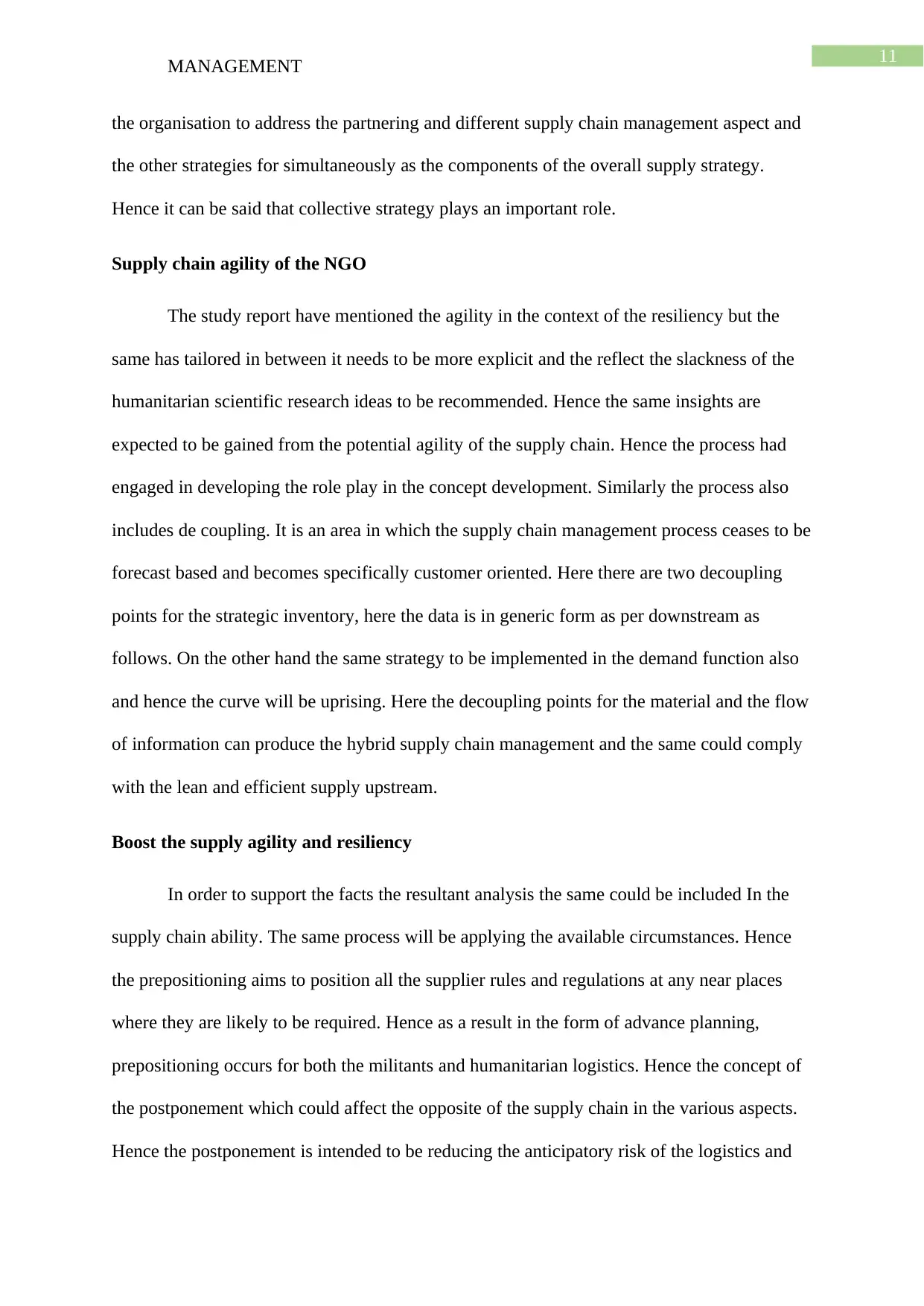
11
MANAGEMENT
the organisation to address the partnering and different supply chain management aspect and
the other strategies for simultaneously as the components of the overall supply strategy.
Hence it can be said that collective strategy plays an important role.
Supply chain agility of the NGO
The study report have mentioned the agility in the context of the resiliency but the
same has tailored in between it needs to be more explicit and the reflect the slackness of the
humanitarian scientific research ideas to be recommended. Hence the same insights are
expected to be gained from the potential agility of the supply chain. Hence the process had
engaged in developing the role play in the concept development. Similarly the process also
includes de coupling. It is an area in which the supply chain management process ceases to be
forecast based and becomes specifically customer oriented. Here there are two decoupling
points for the strategic inventory, here the data is in generic form as per downstream as
follows. On the other hand the same strategy to be implemented in the demand function also
and hence the curve will be uprising. Here the decoupling points for the material and the flow
of information can produce the hybrid supply chain management and the same could comply
with the lean and efficient supply upstream.
Boost the supply agility and resiliency
In order to support the facts the resultant analysis the same could be included In the
supply chain ability. The same process will be applying the available circumstances. Hence
the prepositioning aims to position all the supplier rules and regulations at any near places
where they are likely to be required. Hence as a result in the form of advance planning,
prepositioning occurs for both the militants and humanitarian logistics. Hence the concept of
the postponement which could affect the opposite of the supply chain in the various aspects.
Hence the postponement is intended to be reducing the anticipatory risk of the logistics and
MANAGEMENT
the organisation to address the partnering and different supply chain management aspect and
the other strategies for simultaneously as the components of the overall supply strategy.
Hence it can be said that collective strategy plays an important role.
Supply chain agility of the NGO
The study report have mentioned the agility in the context of the resiliency but the
same has tailored in between it needs to be more explicit and the reflect the slackness of the
humanitarian scientific research ideas to be recommended. Hence the same insights are
expected to be gained from the potential agility of the supply chain. Hence the process had
engaged in developing the role play in the concept development. Similarly the process also
includes de coupling. It is an area in which the supply chain management process ceases to be
forecast based and becomes specifically customer oriented. Here there are two decoupling
points for the strategic inventory, here the data is in generic form as per downstream as
follows. On the other hand the same strategy to be implemented in the demand function also
and hence the curve will be uprising. Here the decoupling points for the material and the flow
of information can produce the hybrid supply chain management and the same could comply
with the lean and efficient supply upstream.
Boost the supply agility and resiliency
In order to support the facts the resultant analysis the same could be included In the
supply chain ability. The same process will be applying the available circumstances. Hence
the prepositioning aims to position all the supplier rules and regulations at any near places
where they are likely to be required. Hence as a result in the form of advance planning,
prepositioning occurs for both the militants and humanitarian logistics. Hence the concept of
the postponement which could affect the opposite of the supply chain in the various aspects.
Hence the postponement is intended to be reducing the anticipatory risk of the logistics and
⊘ This is a preview!⊘
Do you want full access?
Subscribe today to unlock all pages.

Trusted by 1+ million students worldwide
1 out of 17
Related Documents
Your All-in-One AI-Powered Toolkit for Academic Success.
+13062052269
info@desklib.com
Available 24*7 on WhatsApp / Email
![[object Object]](/_next/static/media/star-bottom.7253800d.svg)
Unlock your academic potential
Copyright © 2020–2025 A2Z Services. All Rights Reserved. Developed and managed by ZUCOL.





